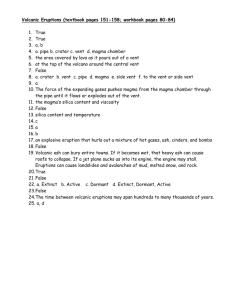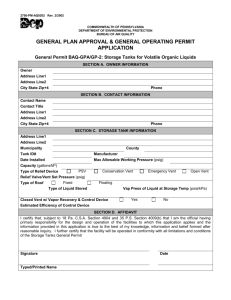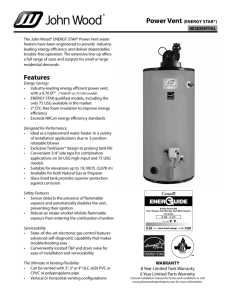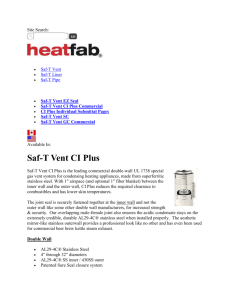Bradford White WARNING INSTALLATION OF VENTING SYSTEM COMPONENTS
advertisement
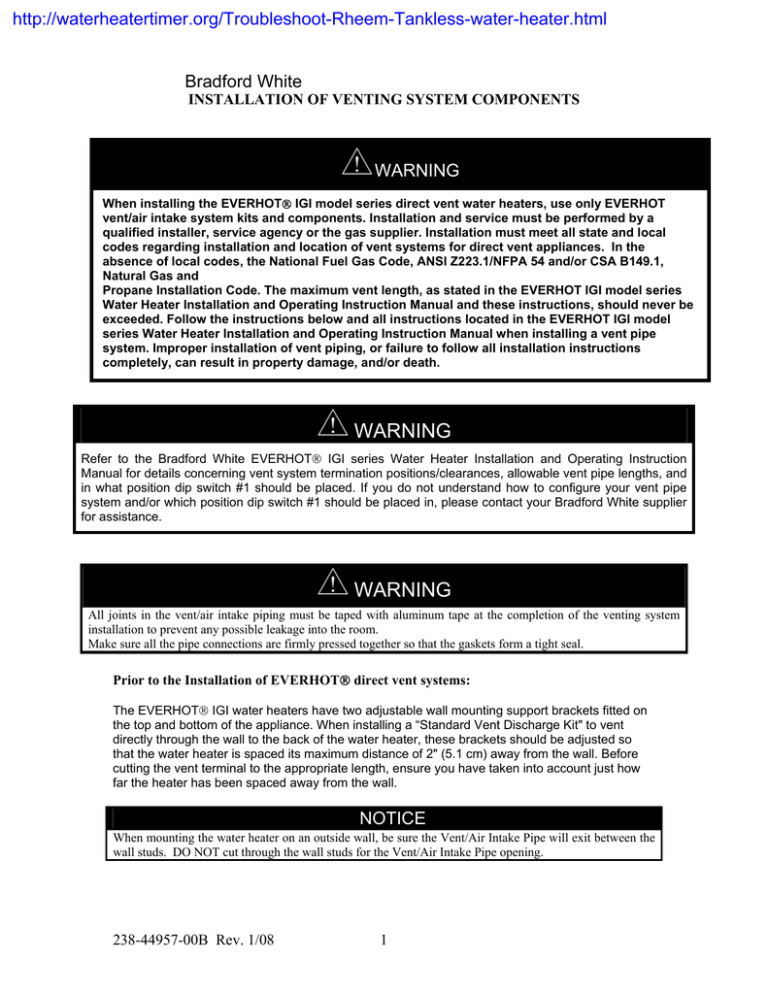
http://waterheatertimer.org/Troubleshoot-Rheem-Tankless-water-heater.html Bradford White INSTALLATION OF VENTING SYSTEM COMPONENTS WARNING When installing the EVERHOT® IGI model series direct vent water heaters, use only EVERHOT vent/air intake system kits and components. Installation and service must be performed by a qualified installer, service agency or the gas supplier. Installation must meet all state and local codes regarding installation and location of vent systems for direct vent appliances. In the absence of local codes, the National Fuel Gas Code, ANSI Z223.1/NFPA 54 and/or CSA B149.1, Natural Gas and Propane Installation Code. The maximum vent length, as stated in the EVERHOT IGI model series Water Heater Installation and Operating Instruction Manual and these instructions, should never be exceeded. Follow the instructions below and all instructions located in the EVERHOT IGI model series Water Heater Installation and Operating Instruction Manual when installing a vent pipe system. Improper installation of vent piping, or failure to follow all installation instructions completely, can result in property damage, and/or death. WARNING Refer to the Bradford White EVERHOT® IGI series Water Heater Installation and Operating Instruction Manual for details concerning vent system termination positions/clearances, allowable vent pipe lengths, and in what position dip switch #1 should be placed. If you do not understand how to configure your vent pipe system and/or which position dip switch #1 should be placed in, please contact your Bradford White supplier for assistance. WARNING All joints in the vent/air intake piping must be taped with aluminum tape at the completion of the venting system installation to prevent any possible leakage into the room. Make sure all the pipe connections are firmly pressed together so that the gaskets form a tight seal. Prior to the Installation of EVERHOT® direct vent systems: The EVERHOT® IGI water heaters have two adjustable wall mounting support brackets fitted on the top and bottom of the appliance. When installing a “Standard Vent Discharge Kit" to vent directly through the wall to the back of the water heater, these brackets should be adjusted so that the water heater is spaced its maximum distance of 2" (5.1 cm) away from the wall. Before cutting the vent terminal to the appropriate length, ensure you have taken into account just how far the heater has been spaced away from the wall. NOTICE When mounting the water heater on an outside wall, be sure the Vent/Air Intake Pipe will exit between the wall studs. DO NOT cut through the wall studs for the Vent/Air Intake Pipe opening. 238-44957-00B Rev. 1/08 1 WARNING All joints in the vent/air intake piping must be taped with aluminum tape at the completion of the venting system installation to prevent any possible leakage into the room. Make sure all the pipe connections are firmly pressed together so that the gaskets form a tight seal. WARNING Before installation inspect each vent component for damage and correct seal placement. Do not attempt to fix or install any damaged vent components. Condensate When the total vent system length is greater than 5 ft. (1,52 m), condensate will form which could damage the water heater. For vent lengths greater than 5 ft. (1,52 m), a condensate collector and trap must be installed. Recommended vent/air intake terminal position Terminals should be so positioned as to avoid products of combustion entering openings into buildings or other flues or vents. Figure 12 2 * For clearances not specified in ANSI Z223.1 / NFP A 54 or CGA-B149, please use clearances in accordance with local installation codes and the requirements of the gas supplier . ** For other than Direct Vent Appliance, 4 feet (1.22 m) below or to side of opening; 1 foot (300 mm) above opening. Troublehoot guideline: Total vent length should not exceed 50 feet 3 General Installation Instructions Joint connection Figure 13 Vent connections others must be firmly pressed together so that the gaskets form an airtight seal. Coping with condensation Figure 14 Make sure that the sockets are pointed 1° upwards in order to keep the gaskets dry. (Except for the (short distance) standard horizontal discharge vent system without extensions. See Figure 34.) Appliance connection Figure 15 The first vent component to the appliance must be a vertical discharge adapter or a horizontal discharge adapter. Never use an extension as the first component, this might cause damage to the water heater and vent system. Secure vent connections with pipe clamps or perforated hanger. 4 Condensate drain Every vent system should have a condensate collector unless installed with a total vent length of less than 5 ft. (1,52 m). To prevent condensate from draining back to the appliance, a condensate collector (B) and trap (C) should be installed. Attach condensate collector to the discharge adapter (A). The trap must be inspected annually for obstructions and water content in the trap. Provisions must be made to properly drain and dispose of condensate; be aware that condensate is a highly corrosive substance that could damage metals. The hose (D) should be subject to inspection; kinks must be avoided. Dispose of condensate in accordance with local codes. Minimum water level in the condensate trap must be 3” (75 mm). Figure 16 Shortening of vent extensions Figure 17 The aluminum inside pipe should always extend 0.4" (10 mm) beyond the white plastic outside pipe on the male end of the vent extension. Always cut the male end of the vent pipe extension. Do not attempt to cut the female end. Figure 18 Pipes overlap by 2.5“ (65 mm). Therefore when cutting to size, add 2.5“ (65 mm) to the extension pipe length (X) needed for installation. Deburr the sharp edges, other wise the gaskets may get damaged, which can result in the system no longer being air tight. 5 WARNING Improper installations of vent system and components, or failure to follow all installation instructions, can result in property damage or serious injury. Parts & Dimensions Components needed for direct vent applications: Figure 19 Figure 20 1) horizontal discharge adapter 2) vertical discharge adapter BWC p/n 239-44506-00 BWC p/n 239-44500-00 Figure 21 Figure 22 3) wall discharge terminal plate Length = 12” (305mm) 4) rubber wall BWC p/n 239-46848-00 Part of BWC vent kit 6 Figure 23 5) vent extension 10” BWC p/n 239-44496-00 19.5” BWC p/n 239-44497-00 39” BWC p/n 239-44498-00 Figure 26 8) condensate collector Figure 24 6) 45º vent pipe elbow (sold in pairs only) BWC p/n 239-44499-00 Figure 27 9) vent pipe clamp BWC p/n 239-44493-00 Figure 29 10) vertical discharge roof terminal BWC p/n 239-44494-00 7) 90 º vent pipe elbow BWC p/n 239-44495-00 BWC p/n 239-44501-00 Figure 28 Figure 25 11) pitch roof flashing (1/12) BWC p/n 239-44502-00 (8/12) BWC p/n 239-44503-00 (6/12) BWC p/n 239-44504-00 7 Figure 30 12) flat roof flashing Figure 31 13) condensate trap kit BWC p/n 239-44492-00 8 Installation Instructions Everhot Horizontal Discharge Vent System Identify the vent location Figure 32 Steps: - Place horizontal discharge adapter on water heater - Mark position on wall - Or use template provided with water heater - Cut hole, covering the top of the water heater to prevent debris from entering Measure dimension to fit Figure 34 Figure 33 NOTICE Note: if the vent system is shorter than 5 ft. (1,52 m) and no condensate collector is installed, be sure to install the wall terminal with a 1° angle to the outside of the building. 9 NOTICE Note: 3.5” (90 mm) is the minimum outer cap length. If needed the length outside the wall may exceed this dimension. Final installation of the venting system Figure 35 From the outside of the building, slide the wall discharge terminal through the vent wall passage. A supplied rubber wall plate can be installed on the exterior of the building. Slide the inner wall plate onto the terminal. If necessary apply silicon sealant to fill up spaces between vent terminal and the wall. Vent connections must be firmly pressed together so that the gaskets form an airtight seal. NOTE When the total vent system length is greater than 5ft. (1,52 m), condensate will form which could damage the water heater. For vent lengths greater than 5ft. (1,52 m), a condensate collector and trap must be installed. 10 Horizontal Vent System Installation examples Figure 36 11 Installation Instructions Everhot Vertical Discharge Vent System Figure 37 Identify the vent location Determine the location where the roof discharge terminal will be installed. Taking into account the angle of the roof, cut the hole with a dimension that allows the vertical discharge roof terminal to be installed. Cut to fit The terminal can be shortened by removing the components A+B+C, and then shortening both the inside and outside pipes with the same length X. Re-assemble the terminal by attaching the components A, B, and C in the correct order. Tighten component B securely. Figure 38 12 Mounting the vent system Figure 39 Vent connections must be firmly pressed together so that the gaskets form an airtightseal. Secure the system with the supplied vent pipe clamp or perforated hanger iron. NOTE When the total vent system length is greater than 5ft. (1,52 m), condensate will form which could damage the water heater. For vent lengths greater than 5ft. (1,52 m), a condensate collector and trap must be installed. 13 Vertical Vent System Installation examples Figure 40 14 Cut Line Template 15

